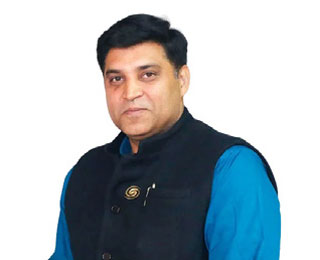Rockets, Satellites, & Stars: Indias Journey Through The Cosmos

Dr. Sachin Bahmba, CMD, Space Group of Companies
India's remarkable journey began with Dr. Vikram Sarabhai's brainchild, the Indian Space Program, in 1962. Since then, India has consistently taken bold strides in space exploration. While there were moments when its scientists faced challenges during mission execution, they emerged stronger each time.
In 1975, India launched its first satellite, Aryabhata, named after the ancient Indian mathematician astronomer. This milestone marked a turning point in India's ambitious foray into the cosmos, showcasing the nation's scientific prowess and laying the foundation for its growing space program.
India's primary objective has always been to utilize its astronomical resources for the greater good, focusing on disseminating fundamental amenities to every individual. These advancements have been instrumental in achieving educational, agricultural, political, and developmental goals that extend beyond economic growth.
In 1975, the Satellite Instructional Television Experiment (SITE) became India's first major satellite-based telecommunications experiment. This initiative facilitated the establishment of community radios in remote areas, providing a vital means of communication for people who lacked access to mainstream media like newspapers, television, and magazines. Community radio bridged the gap, allowing citizens to communicate their concerns to the government and receive solutions in return.
With the resounding success of Chandrayaan-3, there is potential for the government to incorporate modern astronomical tools into the daily functioning of the nation. This step would enhance national security, safety, and literacy levels. With each launch, satellite, and celestial discovery, India's cosmic journey continues to illuminate the path for future generations of explorers.
Artistic works such as "Rocketry: The Nambi Effect," "Mission Mangal," "The First Man," "A Million Miles Away," and others provide a glimpse of the evolving cosmic journey, but to truly comprehend the intricacies of this mind-boggling voyage, one must delve into the realm of scientific exploration.
The Indian Space Research Organization (ISRO), established in 1969, has been the driving force behind India's accomplishments in space exploration, evolving into a global leader in space technology.
"One of SPACE India's remarkable achievements is its collaboration with renowned space agencies such as NASA, ISRO, Principal Scientific Advisor, GoI, etc"
India's most celebrated milestones include the Mars Orbiter Mission (2013), making India the first Asian nation to reach Mars orbit, and Chandrayaan-3 (2023), achieving the first soft landing on the moon's South Pole. India's plans for the Gaganyaan mission, which aims to send Indian astronauts into space, underscore its commitment to human spaceflight.
However, India's cosmic journey has not been without challenges. Space exploration is replete with complexities, from vast distances to technological intricacies. India must continue to invest in research and development, forge international partnerships, and prioritize education to overcome these obstacles.
One of SPACE India's remarkable achievements is its collaboration with renowned space agencies such as NASA, ISRO, Principal Scientific Advisor, GoI, etc. These collaborations facilitate citizen science projects, leading to the discovery of more than 7,000 asteroids by students and involvement in national & international platform events for budding scientists. This impressive work not only contributes to scientific knowledge but also fosters a sense of scientific curiosity with a mission of "Empowering Lives Through Science".
In 1975, India launched its first satellite, Aryabhata, named after the ancient Indian mathematician astronomer. This milestone marked a turning point in India's ambitious foray into the cosmos, showcasing the nation's scientific prowess and laying the foundation for its growing space program.
India's primary objective has always been to utilize its astronomical resources for the greater good, focusing on disseminating fundamental amenities to every individual. These advancements have been instrumental in achieving educational, agricultural, political, and developmental goals that extend beyond economic growth.
In 1975, the Satellite Instructional Television Experiment (SITE) became India's first major satellite-based telecommunications experiment. This initiative facilitated the establishment of community radios in remote areas, providing a vital means of communication for people who lacked access to mainstream media like newspapers, television, and magazines. Community radio bridged the gap, allowing citizens to communicate their concerns to the government and receive solutions in return.
With the resounding success of Chandrayaan-3, there is potential for the government to incorporate modern astronomical tools into the daily functioning of the nation. This step would enhance national security, safety, and literacy levels. With each launch, satellite, and celestial discovery, India's cosmic journey continues to illuminate the path for future generations of explorers.
Artistic works such as "Rocketry: The Nambi Effect," "Mission Mangal," "The First Man," "A Million Miles Away," and others provide a glimpse of the evolving cosmic journey, but to truly comprehend the intricacies of this mind-boggling voyage, one must delve into the realm of scientific exploration.
The Indian Space Research Organization (ISRO), established in 1969, has been the driving force behind India's accomplishments in space exploration, evolving into a global leader in space technology.
"One of SPACE India's remarkable achievements is its collaboration with renowned space agencies such as NASA, ISRO, Principal Scientific Advisor, GoI, etc"
India's most celebrated milestones include the Mars Orbiter Mission (2013), making India the first Asian nation to reach Mars orbit, and Chandrayaan-3 (2023), achieving the first soft landing on the moon's South Pole. India's plans for the Gaganyaan mission, which aims to send Indian astronauts into space, underscore its commitment to human spaceflight.
However, India's cosmic journey has not been without challenges. Space exploration is replete with complexities, from vast distances to technological intricacies. India must continue to invest in research and development, forge international partnerships, and prioritize education to overcome these obstacles.
One of SPACE India's remarkable achievements is its collaboration with renowned space agencies such as NASA, ISRO, Principal Scientific Advisor, GoI, etc. These collaborations facilitate citizen science projects, leading to the discovery of more than 7,000 asteroids by students and involvement in national & international platform events for budding scientists. This impressive work not only contributes to scientific knowledge but also fosters a sense of scientific curiosity with a mission of "Empowering Lives Through Science".

